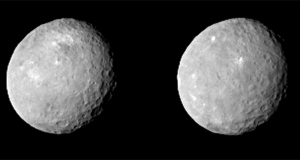A dozen launches for Arianespace in 2015?
The competition heats up: Arianespace’s launch manifest for 2015 predicts a busy year, with a hoped for pace of one launch per month.
What I like most in the article however is what this paragraph says:
The launch provider won nine contracts for geostationary satellites in 2014, and eight of them are the right size to ride in the Ariane 5’s lower berth, [said Stephane Israel, Arianespace’s chairman and CEO] in an interview with Spaceflight Now.
SpaceX has emerged as the chief rival to the veteran French-based launch company, which started the commercial launch business when it was founded in 1980. SpaceX and Arianespace cinched the same number of commercial launch contracts last year. Partly in response to SpaceX’s bargain prices and partly as an initiative to ensure the Ariane 5 has a steady balance of heavier and lighter payloads, Arianespace cut prices for customers with smaller satellites. [emphasis mine]
I love how competition has lowered costs while simultaneously increasing the launch rate for multiple companies. Before SpaceX arrived to challenge established companies like Arianespace the accepted wisdom in the launch industry was that it was foolish to have more rockets capable of launching at lower costs, because there simply wasn’t enough business to justify it. You’d supposedly end up with idle facilities costing money with no payloads to launch. I always thought that theory was hogwash. Elon Musk and SpaceX have definitely proven it so.
The competition heats up: Arianespace’s launch manifest for 2015 predicts a busy year, with a hoped for pace of one launch per month.
What I like most in the article however is what this paragraph says:
The launch provider won nine contracts for geostationary satellites in 2014, and eight of them are the right size to ride in the Ariane 5’s lower berth, [said Stephane Israel, Arianespace’s chairman and CEO] in an interview with Spaceflight Now.
SpaceX has emerged as the chief rival to the veteran French-based launch company, which started the commercial launch business when it was founded in 1980. SpaceX and Arianespace cinched the same number of commercial launch contracts last year. Partly in response to SpaceX’s bargain prices and partly as an initiative to ensure the Ariane 5 has a steady balance of heavier and lighter payloads, Arianespace cut prices for customers with smaller satellites. [emphasis mine]
I love how competition has lowered costs while simultaneously increasing the launch rate for multiple companies. Before SpaceX arrived to challenge established companies like Arianespace the accepted wisdom in the launch industry was that it was foolish to have more rockets capable of launching at lower costs, because there simply wasn’t enough business to justify it. You’d supposedly end up with idle facilities costing money with no payloads to launch. I always thought that theory was hogwash. Elon Musk and SpaceX have definitely proven it so.



